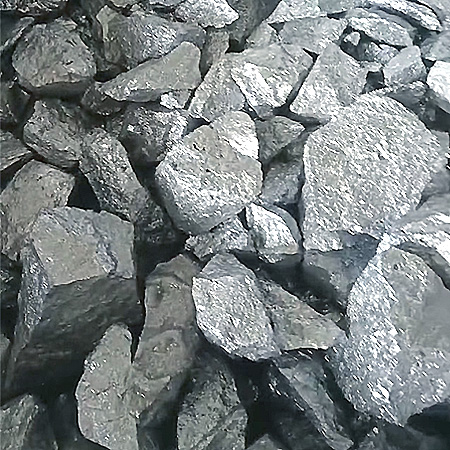Metal silicon can be divided into metallurgical grade metal silicon and chemical grade metal silicon. The silicon content of Metallurgical grade silicon metal is generally above 98.5%. Metallurgical grade silicon metal 553 is a typical model. There are also off grade silicon metal such as Silicon metal 97 Silicon 98, etc. Metallurgical silicon models are mainly for metallurgy industries such as Aluminum alloy, Steel-making. The purity of chemical grade silicon metals are also above98.5%. They are with less impurities and other elements, mainly used as materials in silicone, silanes, etc. Silicon rarely exists in elemental form in nature and is widely found in rocks and dust. Both metallurgy and chemical grades silicon are produced by smelting in electric furnaces using silica and coke as raw materials.
Metallurgical Grade Silicon 553
Metallurgical Grade Silicon Metal 553 is added to cast aluminum alloys to improve metal fluidity and toughness. However, for aluminum alloys, the two elements iron and calcium are generally harmful, so their content needs to be controlled. Therefore, the content of iron and calcium elements in silicon metal 553 must fully meet the standards. Especially, calcium as the key. For example, aluminum alloy model ADC12 is a typical cast aluminum alloy, mainly using silicon metal 553 and off-grade silicon. A356.2 grade primary cast aluminum alloy, mainly using silicon metal 441 and silicon metal 3303. Deformed aluminum alloys have requirements for elements such as phosphorus in industrial silicon, and 2502# and 2202# industrial silicon with fewer impurities are usually used.

Chemical grade silicon is used in the production of silicones and polysilicon. The production of polysilicon is equivalent to the purification of silicon. There are no strict requirements for the grade of industrial silicon. There are requirements for some trace elements, such as boron and carbon that affect photoelectric conversion efficiency. Polysilicon production currently mainly consumes Si 421#, but small amount of metallurgical grade silicon metal 553 and 441 can also be used. With the advancement of production technology, some metallurgical grade silicon have gradually become the mainstream consumer in polysilicon industry.
Metallurgical Grade Silicon Metal 553 with/without Oxgyen
Generally speaking, silicon metal 553 is the most common metallurgy grade silicon. Its silicon content is greater than 98.5%, iron content is less than 5%, aluminum content is less than 0.5%, and calcium content is less than 0.3%. Metal silicon 553 can also be divided into Silicon Metal 553 Oxygen and No Oxygen. Silicon metal 553 oxygen refers to the introduction of oxygen during the production of metallic silicon, and then removes some impurities that are easier to combine with oxygen than silicon, such as aluminum and calcium, which can improve the quality of metallic silicon.
From a global perspective, the usage of metallurgical grade Silicon Metal 553 is still relatively large, and it is mainly used to prepare alloys. Among them, silicon-aluminum alloy is the silicon alloy with the largest usage. Silicon-aluminum alloy is a strong composite deoxidizer that can replace pure aluminum in steelmaking, improve the utilization rate of deoxidizer, purify molten iron, and improve the quality of steel.
The most common particle size of metallurgical grade silicon metal 553 is 10-100mm. Ton bag packaging. As a reputed silicon metal manufacturer, Highrise Metal always provide excellent quality goods and service to customers all over the world.
